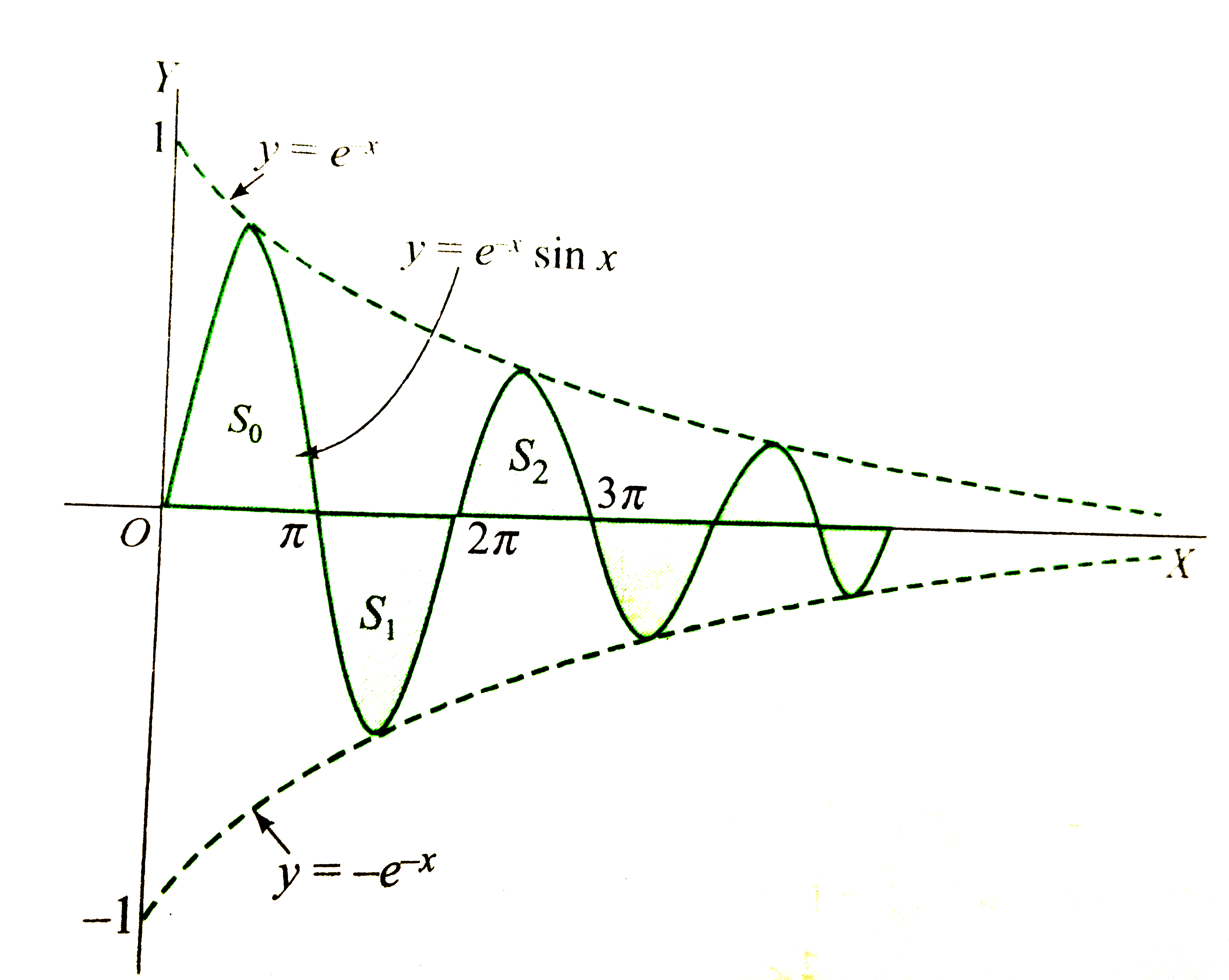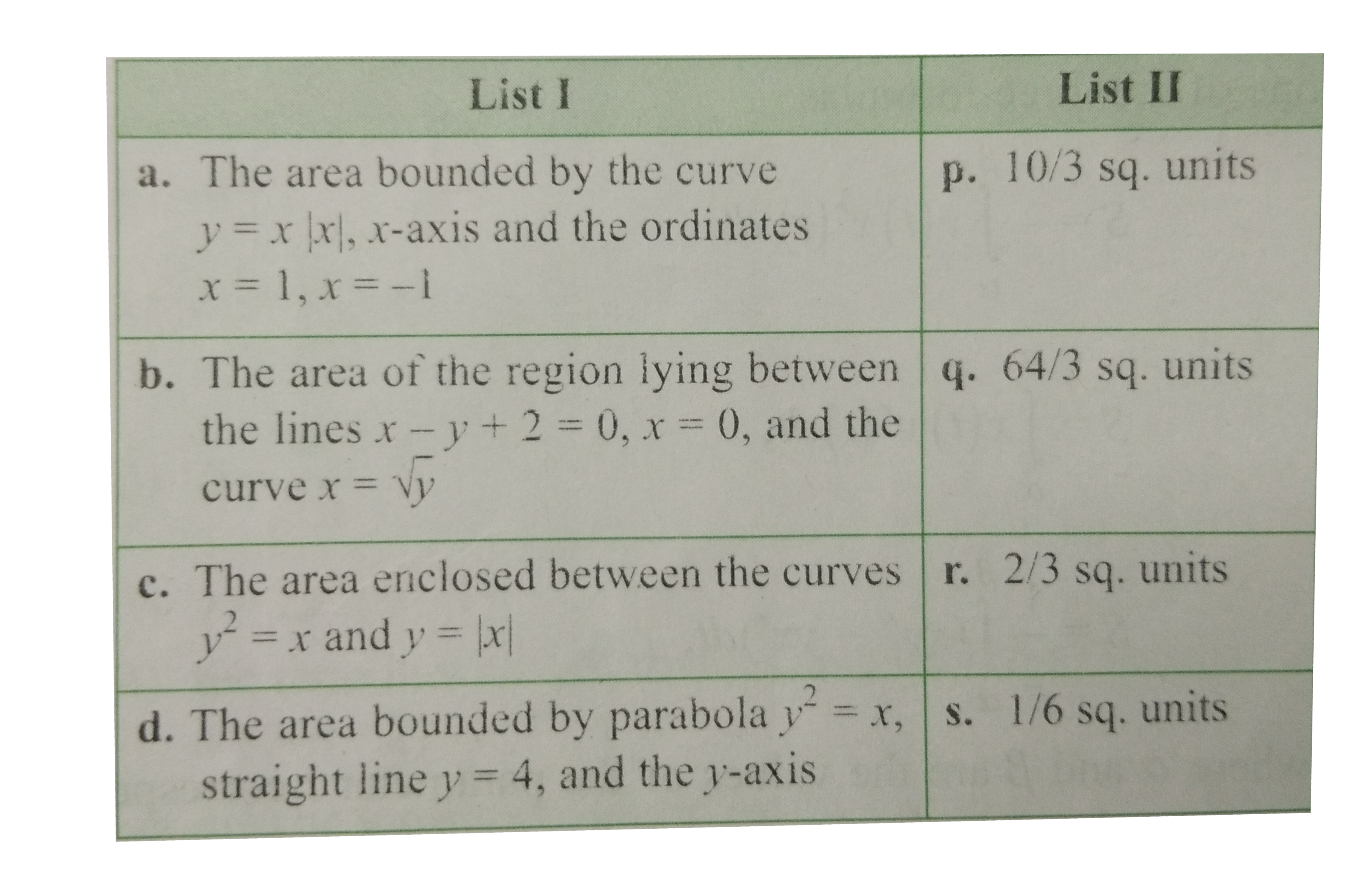If S0,S1,S2,… are areas bounded by the x-axis and half-wave of the curve y=sinπ√x, then prove that S0,S1,S2,… are in A.P…Solution in Bengali
1+eπ1−e−π
12(1+eπ)1−eπ
12(1−e−π)
None of these
The correct Answer is:B
Since −1≤sinx≤1, the curve y=e−xsinx is bounded by the curve y=e−xandy=e−x.

Also, the curve y=e−xsinx intersects the positive semi-axis OX at the points where sin x=0, where xn=nπ,n∈Z.
Also |yn|=|y coordinate in the half-wave Sn|
∴ Sn=(−1)n(n+1)π∫nπe−xsinxdx
=(−1)n+12[e−x(−sinx+cosx)](n+1)πnπ
=(−1)n+12[e−(n+1)x(−1)n+1−enπ(−1)n]
=e−nπ2(1+eπ)
⇒ Sn+1Sn=e−π
and S0=12(1+eπ).
Therefore, the sequence S0,S1,S2,... forms an infinite G.P. with common ratio e−π. we have
∞Σn=0Sn=12(1+eπ)1−e−π
Topper's Solved these Questions
- AREABOOK - CENGAGE PUBLICATIONCHAPTER - AREAEXERCISE - Matrix Match Type
5 Videos
- AREABOOK - CENGAGE PUBLICATIONCHAPTER - AREAEXERCISE - Numerical Value Type
18 Videos
- AREABOOK - CENGAGE PUBLICATIONCHAPTER - AREAEXERCISE - Multiple Correct Answers Type
13 Videos
- APPLICATIONS OF DERIVATIVESBOOK - CENGAGE PUBLICATIONCHAPTER - APPLICATIONS OF DERIVATIVESEXERCISE - Subjective Type
2 Videos
- BINOMIAL THEOREMBOOK - CENGAGE PUBLICATIONCHAPTER - BINOMIAL THEOREMEXERCISE - Comprehension
11 Videos
Similar Questions
Match the following lists :

View SolutionThe area enclosed by the curve c:y=x√9−x2(x≥0) and the x-axis is________
View SolutionLet A(k) be the area bounded by the curves y=x2−3 and y=kx+2 The range of A(k) is (10√53,∞) The range of A(k) is (20√53,∞) If function k→A(k) is defined for k∈[−2,∞ ), then A(k) is many-one function. The value of k for which area is minimum is 1.
View SolutionProve that for λ>1, the equation xlogx+x=λ has least one solution in [1,λ].
View SolutionConsider a G.P. with first term (1+x)n, |x|<1, common ratio 1+x2 and number of terms (n+1). Let 'S' be sum of all the terms of the G.P., then
The coefficient of xn is 'S' is
View SolutionThe parabolas y2=4xandx2=4y divide the square region bounded by the lines x=4,y=4 and the coordinate axes. If S1,S2,S3 are the areas of these parts numbered from top to bottom, respectively, then S1:S2≡1:1 (b) S2:S3≡1:2 S1:S3≡1:1 (d) S1:(S1+S2)=1:2
View SolutionConsider the sequence of natural numbers s_(0),s_(1),s_(2),... such that s_(0)=3,s_(1)=3 and s_(n)=3+s_(n-1)s_(n-2) then
View SolutionConsider curves S1:√|x|+√|y|=√a,S2:x2+y2=a2andS3: |x|+|y|=a. If α is area bounded by S1andS2,β is area bounded by S1andS3andγ is the area bounded by S2andS3, then
View SolutionConsider the area S0,S1,S2…. bounded by the x-axis and half-waves of the curve y=e−xsinx, where x≥0.
The value of S0 is
View SolutionConsider the area S0,S1,S2…. bounded by the x-axis and half-waves of the curve y=e−xsinx, where x≥0.
Σ∞n=0Sn is equal to
View SolutionProve that the areas S0,S1,S2...bounded by the X-axis and half-waves of the curve y=e−axsinβx,x∣0.from a geometric progression with the common ratio g=e−πα/β.
View SolutionIf α,β are the roots of x2+x+1=0, and sn=αn+βn, then ∣∣ ∣∣31+S11+S21+S11+S21+S31+S21+S31+S4∣∣ ∣∣=?
View SolutionLet S1,S2,......S101 be consecutive terms of A.P. If 1S1S2+1S2S3+......+1S100S101=16 and S1+S101=50, then |S1−S101| is equal to
View SolutionIf S0,S1,S2,… are areas bounded by the x-axis and half-wave of the curve y=sinπ√x, then prove that S0,S1,S2,… are in A.P…
View SolutionConsider curves S1:√|x|+√|y|=√a,S2:x2+y2=a2andS3: |x|+|y|=a. If α is area bounded by S1andS2,β is area bounded by S1andS3andγ is the area bounded by S2andS3, then
View SolutionConsider the area S0,S1,S2…. bounded by the x-axis and half-waves of the curve y=e−xsinx, where x≥0.
The value of S0 is
View Solution
